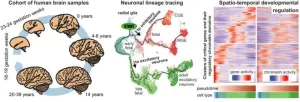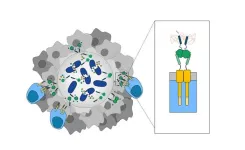(Press-News.org) A team of researchers from the Icahn School of Medicine at Mount Sinai and Yale University School of Medicine has created the first “multiome” atlas of brain cell development in the human cerebral cortex across six broad developmental time points from fetal development into adulthood, shedding new light on their roles during brain development and disease.
“Multiome” refers to the simultaneous analysis of multiple types of genetic information within the same biological sample. They can include the genome, the DNA encoded in our cells; the transcriptome, the RNA copies that the cell makes from the genome; and the epigenome, chemical modifications and regulatory factors that determine the accessibility of chromatin,
As described in Science Advances, the researchers used new scientific tools to analyze and describe two kinds of information from each cell—gene expression (transcriptome) as well as DNA structure (epigenome)—enabling them to categorize cell types at different developmental stages. The data revealed specific changes in the structure of chromatin that precede gene expression. These changes are crucial for numerous processes, including the formation of neurons.
Additionally, their analysis pinpointed regions of chromatin associated with the regulation of genes known to play a pivotal role in human brain development. Notably, they revealed that these regulatory regions are often enriched for genetic signals associated with increased risk for neuropsychiatric disorders such as schizophrenia or bipolar disorder.
“Human brain development starts during embryogenesis and extends postnatally through infancy, childhood, adolescence, and young adulthood,” says Panos Roussos, M.D., Ph.D., Professor of Psychiatry, and Genetics and Genomic Sciences, Director of the Center for Disease Neurogenomics at Icahn Mount Sinai, and senior author of the paper. “Given the variable age of onset of different neurodevelopmental disorders, it is critical to examine the effect of risk factors across the full spectrum of brain development. Through the development of this atlas, we have gained a deeper understanding of the intricate regulatory mechanisms underlying brain development and disease.”
This work was supported by the National Institutes of Health’s Brain Research Through Advancing Innovative Neurotechnologies® Initiative (The BRAIN Initiative®). The comprehensive atlas is now accessible to other researchers through an online repository so others can engage with the data, visualize it effectively, and use it for their own research. The paper is included in a package of 21 research studies across Science, Science Advances and Science Translational Medicine that detail research conducted as part of the National Institutes of Health’s BRAIN Initiative Cell Census Network (BICCN), a program launched in 2017 to create an atlas of the human and non-human primate brain at the cell-type level in unprecedented detail.
The basis for neuropsychiatric disease in adulthood can often be influenced by alterations in the cellular composition of the brain that arise during development. In addition to creating the first atlas of human brain cell development in the human cerebral cortex, the research team prioritized 152 risk genes that play a causal role in a range of neuropsychiatric disorders. Their findings go beyond existing knowledge by mapping cell type and temporally specific genetic loci implicated in neuropsychiatric disorders. For example, they discovered that Tourette syndrome is associated with oligodendrocytes, while obsessive-compulsive disorder is associated with astrocytes. Both of these associations between diseases and cell types were previously unknown, and the discoveries contribute to a deeper understanding of the complex relationships between different cell types and neuropsychiatric disorders.
“It is important to recognize that the most effective therapeutic interventions should be customized to target deficiencies in gene function as specific developmental stages,” says Jaroslav Bendl, Ph.D., Assistant Professor of Psychiatry, and Genetics and Genomic Sciences, at Icahn Mount Sinai and a co-author of the work. “Only by doing so will we be able to minimize further damage and improve outcomes for individuals affected by these disorders.”
Having demonstrated that an atlas of cellular development in the human cerebral cortex was possible, the team is currently expanding their study by analyzing a larger sample cohort and including different brain regions. By so doing, they aim to achieve increased resolution and gain deeper understanding of the intricate regulatory mechanisms and further unravel the complex regulatory logic underling brain development and disease.
Research reported in this press release was supported by the NIH BRAIN Initiative under award number: RF1MH128970. This publication was supported by and coordinated through the BICCN (biccn.org). This publication is part of the Human Cell Atlas (www.humancellatlas.org/publications/).
About the Mount Sinai Health System
Mount Sinai Health System is one of the largest academic medical systems in the New York metro area, with more than 43,000 employees working across eight hospitals, more than 400 outpatient practices, more than 300 labs, a school of nursing, and a leading school of medicine and graduate education. Mount Sinai advances health for all people, everywhere, by taking on the most complex health care challenges of our time—discovering and applying new scientific learning and knowledge; developing safer, more effective treatments; educating the next generation of medical leaders and innovators; and supporting local communities by delivering high-quality care to all who need it.
Through the integration of its hospitals, labs, and schools, Mount Sinai offers comprehensive health care solutions from birth through geriatrics, leveraging innovative approaches such as artificial intelligence and informatics while keeping patients’ medical and emotional needs at the center of all treatment. The Health System includes approximately 7,400 primary and specialty care physicians; 13 joint-venture outpatient surgery centers throughout the five boroughs of New York City, Westchester, Long Island, and Florida; and more than 30 affiliated community health centers. Hospitals within the System are consistently ranked by Newsweek’s® “The World’s Best Smart Hospitals” and by U.S. News & World Report's® “Best Hospitals” and “Best Children’s Hospitals.” The Mount Sinai Hospital is on the U.S. News & World Report's® “Best Hospitals” Honor Roll for 2023-2024.
###
END
Even highly mobile, large, and long-lived species are sensitive to dynamic and changing conditions as the Arctic warms. A new study reports that population swings in eastern North Pacific grey whales – some of which have resulted in recent mass mortality events – are driven by changing prey biomass and ice cover in the Arctic. Climate change is driving rapid change in Arctic ecosystems, including the highly productive shallow basins of the Pacific Arctic, which are critical marine areas that support seasonal foraging opportunities for various migratory marine species. While climate impacts affect lower-trophic level and short-lived species most directly, ...
Two million years ago, Homo erectus had expanded beyond the lowland savanna environments of East Africa and into the high-altitude regions of the Ethiopian highlands, where they produced both Oldowan and Acheulean tools, according to a new study. It presents a reanalysis of an early hominin fossil first discovered in 1981. The findings provide novel insights into the evolution, migration and adaptive capacities of early human ancestors. In Africa, the limited number of hominin fossils found in direct association with stone tools has hindered attempts to link Homo habilis and Homo erectus with ...
A new probiotic-guided chimeric antigen receptor (CAR)-T platform uses engineered bacteria to infiltrate and produce synthetic antigen targets, enabling CAR-T cells to find, identify, and destroy tumor cells in situ, according to a new study. The combined cell therapy platform expands the scope of CAR-T cell therapy to include difficult-to-target solid tumors. Immunotherapies using CAR-T cells have proven successful in treating some types of blood cancers. However, their efficacy against solid tumors remains elusive. A key challenge facing tumor-antigen targeting immunotherapies like CAR-T is the identification of suitable ...
New pharmaceuticals, cleaner fuels, biodegradable plastics: in order to meet society’s needs, chemists have to develop new synthesis methods to obtain new products that do not exist in their natural state. A research group at the University of Geneva (UNIGE), in collaboration with Cardiff University, has discovered how to use an external electric field to control and accelerate a chemical reaction, like a ‘‘switch’’. This work, to be read in Science Advances, could have a considerable impact on the development of new molecules, enabling not only more environmentally friendly synthesis, but also very simple external control of a chemical reaction.
In ...
NEWPORT, Ore. – Dynamic and changing Arctic Ocean conditions likely caused three major mortality events in the eastern North Pacific gray whale population since the 1980s, a new study has found.
During each of these die-offs, including one that began in 2019 and is ongoing, the gray whale population was reduced by up to 25% over just a few years, said Joshua Stewart, an assistant professor with Oregon State University’s Marine Mammal Institute and the study’s lead author.
“These are extreme population swings that we did not expect to see in a large, long-lived species like gray whales,” Stewart said. “When the availability ...
In two parallel projects, researchers at Karolinska Institutet have been involved in creating the most comprehensive atlases of human brain cells to date. The two studies, which are published in Science, provide clues on different brain diseases and give hope for medical advancements in the future, such as new cancer drugs.
Knowing what cells constitute the healthy brain, where different cell types are located and how the brain develops from the embryo stage is fundamental to the ability to compare and better understand how diseases arise. There are at present advanced atlases of the ...
Tropical crops such as coffee, cocoa, watermelon and mango may be at risk due to the loss of insect pollinators, finds a new study led by UCL and Natural History Museum researchers.
Published in Science Advances, the study explores the intricate interplay between climate change, land use change, and their impact on pollinator biodiversity, ultimately revealing significant implications for global crop pollination.
The study, which compiled data from 1,507 crop growing sites around the world and catalogued 3,080 insect pollinator species, exposes a concerning trend – the combined pressures ...
A group of international scientists have mapped the genetic, cellular, and structural makeup of the human brain and the nonhuman primate brain. This understanding of brain structure, achieved by funding through the National Institutes of Health’s Brain Research Through Advancing Innovative Neurotechnologies® Initiative, or The BRAIN Initiative®, allows for a deeper knowledge of the cellular basis of brain function and dysfunction, helping pave the way for a new generation of precision therapeutics for people with mental disorders and other disorders of the brain. The findings appear in a compendium of ...
New York, NY—October 12, 2023—For several years, researchers have been successfully using chimeric antigen receptor (CAR) T cells to target specific antigens found on blood cells as a cure for patients with leukemia and lymphoma. But solid tumors, like breast and colon cancers, have proven to be more difficult to home in on. Solid tumors contain a mix of cells that display different antigens on their surface-often shared with healthy cells in the body. Thus, identifying a consistent and safe target has impeded the success of most CAR-T cell therapy for solid tumors at the first phase ...
Tobacco is the leading cause of preventable death in the United States, according to the Centers for Disease Control and Prevention, and cigarette smoking causes three in 10 of all cancer deaths. Smoking also accounts for more than 30 percent of the difference in life expectancy among different socioeconomic groups.
Roberta Freitas-Lemos, research assistant professor at the Fralin Biomedical Research Institute at VTC, recently received a career development award to explore the ways in which nicotine tax policies can influence health disparities. The award of more than $680,000 over five years from the National Cancer Institute of the National Institutes of Health is designed ...






